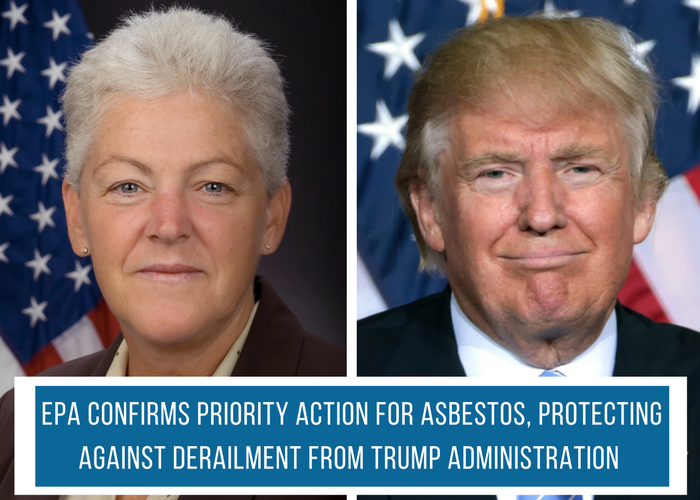
Asbestos has been killing unwitting Americans for more than a century, but today the U.S. Environmental Protection Agency (EPA) took a historic step toward ending this tragic trend.
Asbestos will be one of the first 10 high-risk chemicals evaluated and regulated as the EPA implements the Lautenberg Act, putting us on the path to finally achieving a federal ban.
This couldn’t come at a more crucial time. President-elect Trump has made clear his intentions to scale back the EPA drastically, and he’s also given high praise to asbestos, has used it heavily in his own real estate developments, and claims the movement to ban asbestos is a mafia conspiracy. Anti-asbestos advocates have been rightfully concerned that if asbestos wasn’t addressed before Trump takes office, it could mean a resurgence in use rather than restrictions.
By including asbestos in this top 10 list for priority action, the outgoing EPA team set legally enforceable deadlines and requirements around asbestos assessment and regulation, avoiding the concerns of Trump derailing our fight for a federal ban on this deadly toxin. Fortunately, these forthcoming regulations are mandated by a congressionally passed law and are not easily reformed or repealed.
On the Path to a Ban
With asbestos locked in for early action, we’re on a 3-5 year timeline to regulation that looks something like this:
- EPA must release a scoping document within six months for each chemical, which will include the hazards, exposures, conditions of use, and vulnerable populations the agency plans to consider for the risk evaluation.
- EPA will be under statutory deadline to complete a risk evaluation within 3 years to determine whether the chemicals present an unreasonable risk to humans and the environment.
- If a chemical is found to pose unreasonable risk, EPA must take regulatory action to mitigate that risk within two years.
This means a final rule — one that bans asbestos in all forms — would likely be enacted by 2021. But given the extensive legwork that EPA has already done evaluating the dangers of asbestos, there’s a potential that this could happen even sooner.
“EPA spent 10 years exploring the need for the asbestos ban and developing the regulation. On the basis of its review of over 100 studies of the health risks of asbestos as well as public comments on the proposed rule, EPA determined that asbestos is a potential carcinogen at all levels of exposure — that is that it has no known safe exposure level,” Natural Resource and Environment Director John Stephenson said in a 2006 testimony before the U.S. Senate Committee on Environment and Public Works.
“President-elect Trump has made clear his intentions to scale back the EPA drastically, and he’s also given high praise to asbestos, has used it heavily in his own real estate developments, and claims the movement to ban asbestos is a mafia conspiracy.”
EPA has already tried to ban asbestos, based on the evidence from this decade of research. In 1989, EPA issued a full federal ban on asbestos, only to have it overturned when the chemical industry sued, claiming the restriction would be bad for business. The EPA’s inability to regulate one of the most notoriously lethal chemicals in existence highlighted the need to empower the agency with stronger chemical safety laws that would prioritize public health over profits. In fact, when President Obama signed into law the Lautenberg Act reforms that expanded the EPA’s authority, he singled out asbestos as the poster child for the failure of the chemical safety laws we’d been living under since the 70s.
Righting a Century of Wrongs
“Under the new law, we now have the power to require safety reviews of all chemicals in the marketplace,” EPA Assistant Administrator Jim Jones said in a statement. “We can ensure the public that we will deliver on the promise to better protect public health and the environment.”
The new law includes some key points that will prevent chemical industry lobbyists from upending this important work — namely, requiring EPA to review existing and new chemicals based on a health-based standard, and not the cost of any restriction or ban. This measure will prove invaluable, as the chemical industry wasted no time mounting their opposition to the top 10 announcement and the evaluations to follow.
“It is important to note that a chemical’s inclusion in this first group of ten chemicals does not in and of itself indicate anything about the safety of the chemical. Its listing is simply an acknowledgment by the Agency that it plans to conduct risk evaluations on these ten chemicals before others,” the American Chemistry Council (ACC) said in a statement. The ACC represents the chloralkali industry — responsible for nearly 90% of U.S. asbestos consumption — and has worked long and hard to keep asbestos in legal in efforts to protect their profit margin, regardless of the irreversible harm they cause with continued use.
Today, the EPA followed through on this promise to protect public health and the environment from unnecessarily dangerous chemicals regardless of industry pressure, signaling the success of the Lautenberg Act reforms. For the Asbestos Disease Awareness Organization (ADAO) and asbestos victims everywhere, this is a significant victory in a years-long David and Goliath battle that pitted victims against deep-pocketed chemical industry lobbyists. Today, with the help of a forward-thinking EPA, Congressional champions, and countless supporters, we’ve proven that with enough grit, determination, and faith in the democratic process, the Davids of the world truly can make change happen.
